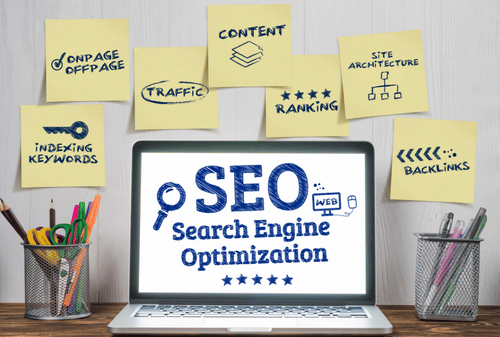
Search Engine Optimisation (SEO) is encompasses a range of techniques and best practices designed to enhance organic (non-paid) traffic from search engines like Google, Bing, and Yahoo
The Importance of SEO
- Increased Visibility: Ranking higher in search engine results increases your website’s visibility to potential visitors who are actively searching for products, services, or information related to your industry.
- Organic Traffic: SEO focuses on driving organic traffic, which refers to visitors who find your website through unpaid search results.
- Credibility and Trust: Websites that rank prominently in search results are perceived as more credible and trustworthy by users. A strong SEO presence can enhance your brand’s reputation and authority within your niche.
- Cost-Effectiveness: SEO offers a cost-effective long-term strategy for attracting relevant traffic.
- Competitive Advantage: Effective SEO can give your business a competitive edge by outranking competitors, attracting more leads, and gaining market share.
Key Components of SEO

1. On-Page SEO:
On-page SEO involves optimising individual web pages to improve their search engine rankings and organic traffic. Key elements of on-page SEO include:
- – Keyword Optimization**: Researching and strategically using relevant keywords throughout your content, meta tags, headings, and URLs.
- – Meta Tags: Optimizing meta titles, meta descriptions, and meta tags with targeted keywords and compelling information.
- – URL Structure: Ensuring clear, descriptive, and SEO-friendly URLs that are easy for both users and search engines to understand.
- – Internal Linking: Linking to other relevant pages within your website to improve navigation and enhance SEO.
2. Off-Page SEO:
Off-page SEO focuses on factors outside your website that influence search engine rankings. Key off-page SEO techniques include:
- – Backlink Building: Acquiring high-quality backlinks from reputable and relevant websites, which signals authority and trustworthiness to search engines.
- – Social Signals: Engaging on social media platforms and generating social signals (likes, shares, comments) that contribute to brand visibility and online presence.
3. Technical SEO:
Technical SEO deals with the technical aspects of website optimisation that impact search engine crawling, indexing, and user experience. Key technical SEO practices include:
- – Site Speed Optimisation: Improving page loading times for better user experience and search engine performance.
- – Mobile-Friendliness: Ensuring that your website is responsive and optimized for mobile devices, as mobile usability is a significant ranking factor.
- – Schema Markup: Implementing structured data markup to help search engines understand and display content more effectively in SERPs.
- – Crawl ability and Indexing: Optimising robots.txt files, XML sitemaps, and internal linking structures to ensure search engines can crawl and index your website efficiently.
4. Local SEO:
It involves optimising your online presence to appear in local search results, Google Maps, and local directories. Key elements of local SEO include:
- – Google My Business (GMB) Optimisation: Creating and optimising your GMB profile with accurate business information, photos, reviews, and updates.
- – Local Citations: Building citations (mentions of your business name, address, and phone number) on local directories, review sites, and online listings.
SEO Strategies and Best Practices
1. Keyword Research:
Use tools like Google Keyword Planner, SEMrush, and Ahrefs to discover keyword opportunities and assess search volumes, competition, and user intent.
2. Content Optimisation:
Create and optimise high-quality content that aligns with user search intent and addresses common queries and pain points. Incorporate target keywords naturally within your content, headings, meta tags, and image alt text. Aim for readability, relevance, and depth in your content to engage users and encourage sharing and backlinks.
3. Technical Optimisation:
Audit and optimise your website’s technical aspects, including site speed, mobile responsiveness, URL structure, meta tags, schema markup, and internal linking.
4. Link Building:
Develop a strategic link-building strategy to acquire high-quality backlinks from authoritative and relevant websites. Focus on natural link acquisition through guest blogging, influencer outreach, content partnerships, and industry directories. Avoid black hat SEO tactics like buying links or engaging in link schemes that can result in penalties from search engines.
5. Local SEO Optimisation:
If your business serves a local audience, optimise your online presence for local search. Claim and optimise your Google My Business listing, ensure NAP (name, address, phone number) consistency across online directories, solicit positive reviews from satisfied customers, and create localized content and landing pages.
6. User Experience (UX) Optimisation:
Prioritise user experience by optimising website navigation, page layouts, CTAs (calls-to-action), and load times. Ensure intuitive site architecture, clear navigation paths, mobile-friendly design, fast loading speeds, and secure HTTPS connections. A positive UX enhances engagement, reduces bounce rates, and improves SEO performance.
7. Analytics and Monitoring:
Use web analytics tools like Google Analytics and Google Search Console to track and analyse SEO performance metrics. Monitor key metrics such as organic traffic, keyword rankings, backlinks, conversion rates, and user behavior. Use data-driven insights to identify opportunities, measure ROI, and refine your SEO strategies over time.
Conclusion
SEO is a dynamic and essential digital marketing discipline that empowers businesses to enhance their online visibility, attract targeted traffic, and achieve sustainable growth. By understanding the key components, implementing effective strategies, and adhering to best practices, businesses can improve their search engine rankings, drive organic traffic, and capitalize on valuable opportunities in the competitive online landscape. Consistent effort, continuous optimization, and a user-centric approach are key to unlocking the full potential of SEO and maximizing long-term success.









